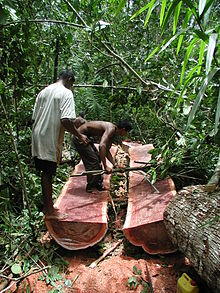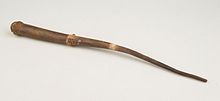- Manilkara bidentata
-
"Balata" redirects here. For other uses, see Balata (disambiguation).
Manilkara bidentata Scientific classification Kingdom: Plantae (unranked): Angiosperms (unranked): Eudicots (unranked): Asterids Order: Ericales Family: Sapotaceae Genus: Manilkara Species: M. bidentata Binomial name Manilkara bidentata
(A.DC.) A.Chev.[1]Synonyms Mimusops bidentata A.DC.
Mimusops globosa C.F.Gaertn.
Mimusops balata Crueg. ex Griseb.Manilkara bidentata is a species of Manilkara native to a large area of northern South America, Central America and the Caribbean. Common names include balatá, ausubo, massaranduba, and (ambiguously) "cow-tree".
Balatá is a large tree, growing to 30–45 m tall. The leaves are alternate, elliptical, entire, and 10–20 cm long. The flowers are white, and are produced at the beginning of the rainy season. The fruit is a yellow berry, 3–5 cm in diameter, which is edible; it contains one (occasionally two) seed(s). Natural latex is made from its sap.
Uses
The latex is extracted in the same manner in which sap is extracted from the rubber tree. It is then dried to form an inelastic rubber-like material. It is almost identical to gutta-percha (produced from a closely related southeast Asian tree), and is sometimes called gutta-balatá.
Balatá was often used in the production of high-quality golf balls, to use as the outer layer of the ball. Balatá-covered balls have a high spin rate, but do not travel as far as most balls with a Surlyn[5] cover. Due to the nondurable nature of the material the golf club strikes, balatá-covered balls do not last long before needing to be replaced. While once favored by professional and low-handicap players, they are now obsolete, replaced by newer Surlyn and urethane technology.
Balatá trees are farmed along the banks of the Amazon River and its tributaries, such as the Içá. It is also the most important timber tree on Puerto Rico.
The tree is a hardwood with a red heart, which is used for furniture and as a construction material where it grows. Locals often refer to it as bulletwood for its extremely hard wood, which is so dense that it does not float in water. Drilling is necessary to drive nailed connections. In trade, it is occasionally (and incorrectly) called "brazilwood".
The fruit, like that of the related sapodilla (M. zapota), is edible. Though its heartwood may present in a shade of purple, Manilkara bidentata should not be confused with another tropical tree widely known as "purpleheart", Peltogyne pubescens.[6]
References
- ^ a b Rev. Bot. Appliq. 1932, xii. 270. "Plant Name Details for Manilkara bidentata". IPNI. http://www.ipni.org:80/ipni/idPlantNameSearch.do?id=787598-1. Retrieved December 25, 2009. "Notes: Mimusops bidentata"
- ^ Prodr. (DC.) 8: 204. 1844 [mid Mar 1844] "Plant Name Details for Mimusops bidentata". IPNI. http://www.ipni.org:80/ipni/idPlantNameSearch.do?id=787862-1. Retrieved December 25, 2009. "Notes: =globosa"
- ^ Suppl. Carp. 132 (t. 205). 1807 "Plant Name Details for Mimusops globosa". IPNI. http://www.ipni.org:80/ipni/idPlantNameSearch.do?id=787937-1. Retrieved December 25, 2005.
- ^ "Mimusops balata Crueg. ex Griseb.". The Plant List. Royal Botanic Gardens, Kew and Missouri Botanical Garden. http://www.theplantlist.org/tpl/record/kew-128391. Retrieved August 4, 2011.
- ^ TM: http://www2.dupont.com/Surlyn/en_US/
- ^ http://www.simonandshock.com/lumber.htm
Categories:- Manilkara
- Plants described in 1807
- Trees of Brazil
- Trees of Colombia
- Trees of Dominica
- Trees of Ecuador
- Trees of French Guiana
- Trees of Guyana
- Trees of Hispaniola
- Trees of Martinique
- Trees of Suriname
- Trees of Panama
- Trees of Peru
- Trees of Puerto Rico
- Trees of Trinidad and Tobago
- Trees of Venezuela
- Trees of the Virgin Islands
Wikimedia Foundation. 2010.


